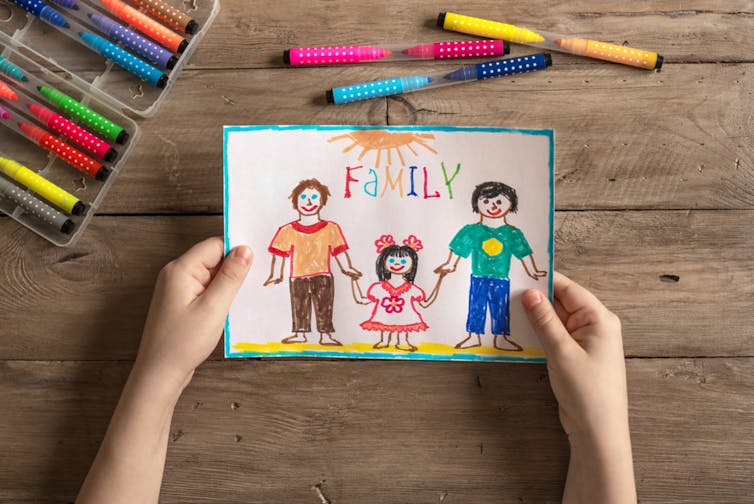The UK’s High Court has ruled that Freddy McConnell, a man who gave birth to his child, does not have the right to be registered as a “father” on his child’s birth certificate. McConnell, who is transgender, has indicated his intention to appeal.
At present, people who give birth to a child in the UK are always registered as the “mother”. However, this does not accurately reflect the lived reality of a growing number of transgender birth parents, and can therefore create inconsistencies. For example, McConnell is, for all other social and legal purposes, a man. As his legal team note: “Freddy is legally a man and his legal papers display the same.”
As a researcher, I work for the Trans Pregnancy Project, an international study examining trans and non-binary people’s experiences of pregnancy and childbirth. We have conducted in-depth interviews with 50 people about their experiences of pregnancy in Australia, Bulgaria, Canada, Germany, the US and the UK. We have also spoken to young trans and non-binary people who are considering their options for parenthood as well as medical professionals working with these groups. We found that birth parents seek forms of legal recognition that are consistent with how they experience gender in their everyday life.
Giving birth as a man
Many trans people undertake a social or medical transition that does not involve surgery to remove their reproductive organs. Therefore transition does not necessarily take away the ability or desire to reproduce. As Jonathan*, a participant in our research, argued:
I do want a child that’s biologically mine and I can get pregnant … I do have the ability to do that, so why should I not make use of that?
It is not just trans men who might choose to become pregnant. This can also be an option for many non-binary or genderqueer people: that is, individuals whose gender is partly or entirely separate from the binary options of female and male.
Trans people may conceive in a variety of ways: through intercourse, sperm donation, or assisted reproductive technologies. If a trans person is taking testosterone, it is typical for them to pause their medication regime some months before they conceive. There are, however, cases of people becoming unintentionally pregnant while undergoing hormone therapy, as testosterone is not a reliable contraceptive.
More common than you may think
There are no firm statistics available on the number of trans and non-binary people who become pregnant and give birth. However, our research indicates that a growing number of trans people are choosing to start their own families in this way. More than 4,500 people worldwide are members of a private social media group for trans people who give birth.
In Australia, the only country known to collect statistics on male birth parents, 205 men are recorded to have given birth between 2013 and 2018. As research participant Joseph* explained: “It’s not a new story, it’s not sensational.”
Modern families
Some of the reporting on McConnell’s case in the British media has used quite emotive language. In stating that his child may be “without mother”, the implication was that something important might be lost.
But many children have been born to men and non-binary people. Some are in relationships with women who become the mothers of their children while others are single, or in relationships with other men or non-binary people. More broadly, there are many ways in which a child might grow up without a mother – if their mother dies in childbirth, if they are raised solely by male relatives, or are adopted by a male couple or single male parent.

What is missing from the reporting on the McConnell case is an account of what has been gained. Children gain a loving parent, and their parents gain an addition to their family.
A difficult road forward
Participants in our study reported a range of different experiences and views on matters such as gender, parenthood and being trans and/or non-binary. Nevertheless, all emphasised the importance of recognising that some people who give birth may be fathers or non-binary parents.
Trans and non-binary birth parents want fair and equitable access to social and healthcare services, and respect for their experiences. When pregnancy is conceptualised as something that can only affect women, then men and non-binary people can be excluded from services and legal protections, with potentially tragic consequences.
Many participants emphasised their fears around registering their child’s birth. It is possible for a birth parent to be registered as the “father” or simply the “parent” of their child in countries such as Sweden, and in some Canadian provinces and US states.
However, participants in countries such as the UK and Germany described difficulties associated with being forced to register as the “mother” of their child. For example, Stefan asked the registrar: “How I should demonstrate or prove or verify that he’s my son with this birth certificate, because nobody would believe me.”
For these people, having their gender appropriately recorded on their child’s birth certificate is a matter of basic dignity. But mostly importantly, it is a matter of respect and safety for the child. Parents such as Stefan echoed McConnell, who has stated that “protecting my child has always been … my number one concern”. In expressing fears for the future of their children, they note the potential confusion that can arise from a child’s documentation being inconsistent with that of their parents.
Family forms and structures have changed many times through history and are still changing. Families with trans parents exist and they are here to stay. It is incumbent upon us to do what we can to best understand the unique characteristics, needs, challenges and strengths of these 21st-century families.
* All names of research participants have been changed to protect their privacy.

